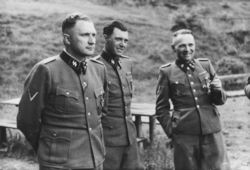- The Institute
- Research
- Dictatorships in the 20th Century
- Democracies and their Historical Self-Perceptions
- Transformations in Most Recent History
- International and Transnational Relations
- Edited Source Collections
- Dissertation Projects
- Completed Projects
- Dokumentation Obersalzberg
- Center for Holocaust Studies
- Berlin Center for Cold War Studies
- Publications
- Vierteljahrshefte
- The Archives
- Library
- Center for Holocaust Studies
- News
- Dates
- Press
- Recent Publications
- News from the Institute
- Topics
- Munich 1972
- Confronting Decline
- Feminist, Pacifist, Provocateur
- Der Mauerbau als Audiowalk
- Digital Contemporary History
- Transportation in Germany
- Envisaged Futures at the End of the Cold War
- From the Reichsbank to the Bundesbank
- German Federal Chancellery
- History of Sustainabilities: Discourses and Practices since the 1970s
- Changing Work
- Democratic Culture and the Nazi Past
- The History of the Treuhandanstalt
- Foreign Policy Documentation (AAPD)
- Dokumentation Obersalzberg
- Hitler, Mein Kampf. A Critical Edition
- "Man hört, man spricht"
- Dictatorships in the 20th Century
- Democracies and their Historical Self-Perceptions
- Transformations in Most Recent History
- International and Transnational Relations
- Edited Source Collections
- Dissertation Projects
- Completed Projects
- Dokumentation Obersalzberg
- Center for Holocaust Studies
- Berlin Center for Cold War Studies
Rudolf Höss – Practices, Relationships and Private Life of a Concentration Camp Commandant
Abgeschlossenes ProjektProjektinhalt:
The shaping of political power in the Nazi concentration camp system was closely tied to the biographies of the SS elite, their personal networks, and their everyday practices. The reach of action exercised by the camp commandant at the largest concentration and extermination camp was, for example, influenced primarily by those in close institutional proximity. Due to his behavior, Rudolf Höss is regarded as a synonym for the precisely organized and industrial implementation of mass murder at Auschwitz-Birkenau.
In Anna-Raphaela Schmitz’s doctoral project on the concentration camp commandant Rudolf Höss, the hitherto personalized approach has been expanded to connect it with structural and biographical history. The dissertation examines the planning and execution of mass murder by Rudolf Höss both from an everyday history and micro-historical perspective. The camp commandant was not just a political official acting only within a fixed framework of action, but he also developed new concepts of his own and made use of networks within and beyond the camp walls. Using a “praxeological” biography of the commandant, the study analyses the fixed framework conditions put in place by the National Socialist leadership as well as the patterns of action and social interactions of the perpetrators at Auschwitz-Birkenau. The relationship between Höss and the camp personnel was not solely limited to everyday concentration camp operations but extended to social and cultural events outside working hours as well. The maintenance of family structures as well as the concession of free spaces for intimacy was meant to uphold the appearance of a subjective “normality” as much as possible.
Rudolf Höss’ mentality was formed in particular by his deep rootedness in the Nazi “movement” from its beginnings. The study is to investigate, using the method of network analysis, the interactions among the perpetrators as well as the interlinkage of the institutional and personal levels both within and beyond the camp walls. An examination of the concentration camp commandant from the various perspectives of different groups and his place within the social context of the Nazi regime combine to form the starting point for this doctoral project.






